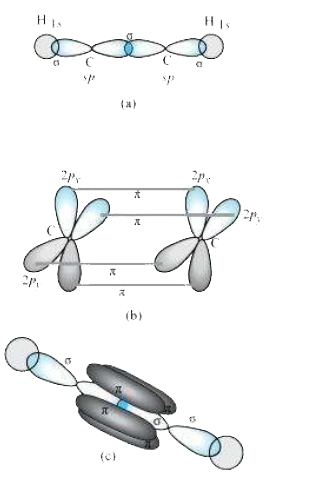Draw diagrams showing the formation of a double bond and a triple bond between carbon atoms in C2H4 and C2H2 molecules.
Video Solution
Text Solution
C2H4:
The electronic configuration of C-atom in the excited state is :
6C=1s22s12p1x2p1y2p1z
In the formation of an ethane molecule (C2H4), one sp2 hybrid orbital of carbobn overlaps a sp2 hybridized orbital of another carbon atom, thereby forming a C-C sigma bond. The remaining two sp2 orbitals of each carbon atom form a sp2−S sigma bond with two hydrogen atoms. The unhybridized orbital of one carbon atom undergoes sidewise overlap with the orbital of a similar kind present on another carbon atom to form a weak π-bond.

C2H2
In the formation of C2H2 molecule, each c-atom is sp hybirdized with two 2p-orbitals in an unhybridized state.
One sp orbital of each carbon atom overlaps with the other along the internuclear axis forming a C-C sigma bond. The second sp orbital of each C-atom overlaps a half-filled 1s-orbital to form a σ bond.
The two unhybirdized 2p-orbitals of the first carbon undergo sidewise overlap with the 2p orbital of another carbon atom, thereby forming two pi (π) bonds between carbon atoms. Hence, the triple bond between two carbon atoms is mad3e up of one sigma and two π-bonds.

|
Topper's Solved these Questions
Similar Questions
Knowledge Check
The number and type of bonds between two carbon atoms in C2 are:
Aone sigma (σ) and one pi (π) bondsBtwo pi (π) bondsCone sigma (σ) and one half pi (π) bondsDone sigma (σ) bondThe double bond between the two carbon atoms in the C_(2)H_(4) molecule indicates
ATwo pairs of mobile electronsBTwo pairs of shared electronsCTwo pairs of unpaired electronsDTwo pairs of lone electronsWhich is the correct order of bond energy of single, double and triple bonds between carbon atoms ?
AC−C>C=C>C≡CBC=C>C≡C>C−CCC≡C>C−C>C=CDC≡C>C=C>C−C
A double bond between two carbon atoms is formed by
View SolutionTaking a suitable example show the formation of a molecule bonded by triple covalent bond.
View SolutionA double bond between two carbon atoms is formed by _____.
View SolutionHow many sigma and pi bonds are present in a) C2H2 b) C2H4
View SolutionWhat is the nature of the bond between B and O in (C2H5)2OBH3
View Solution
